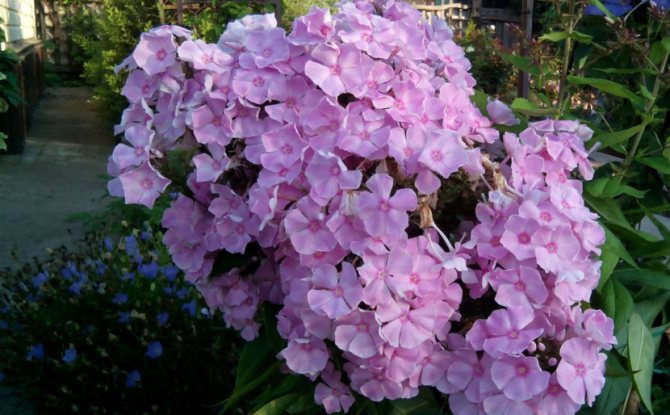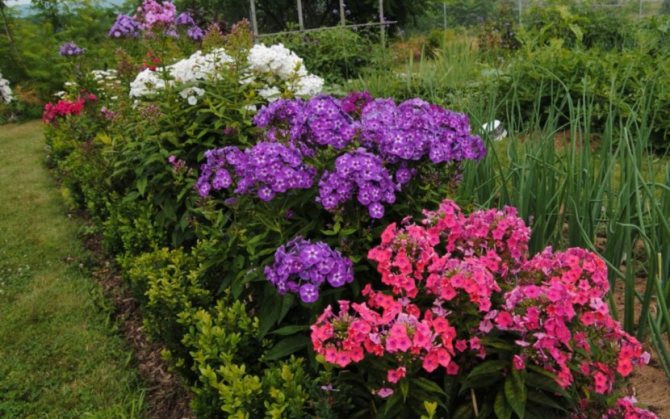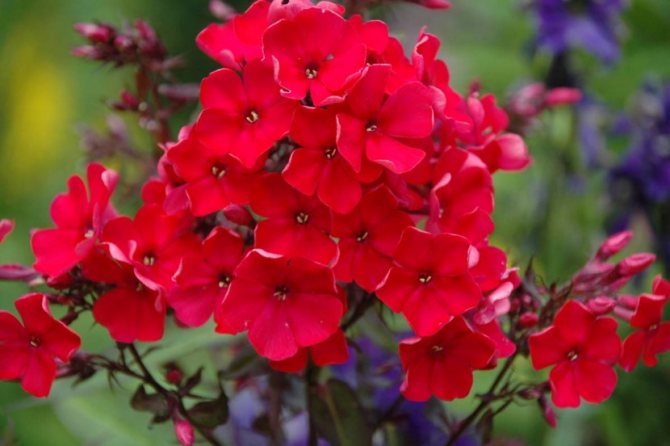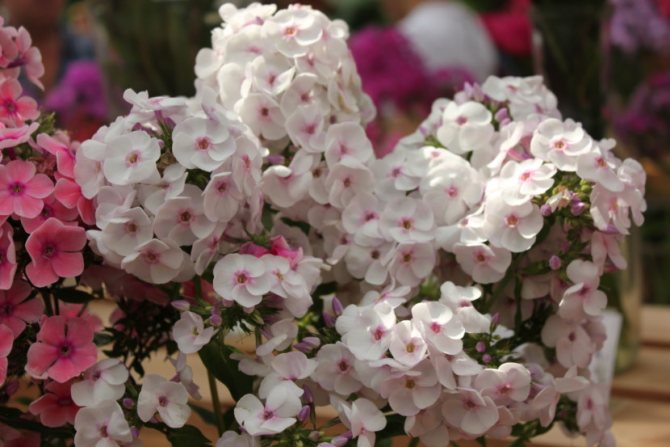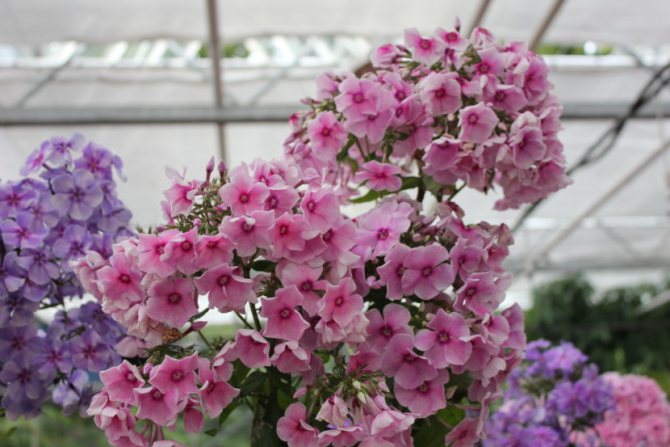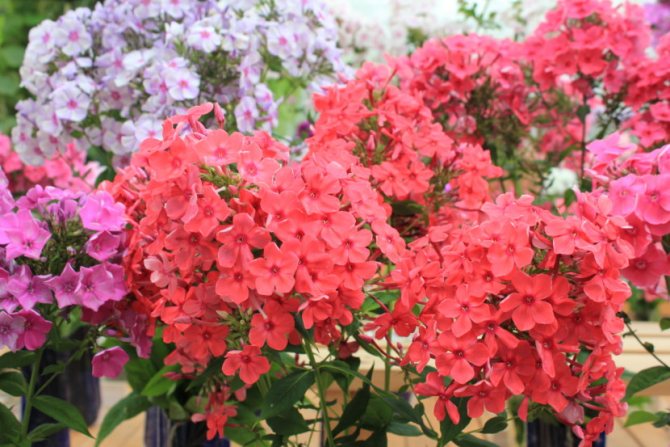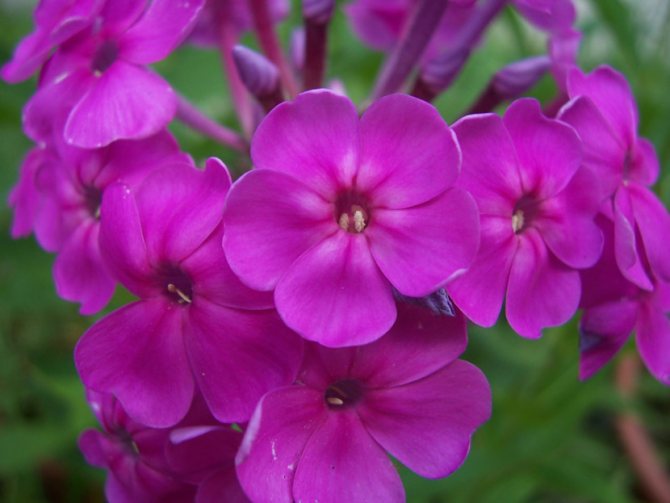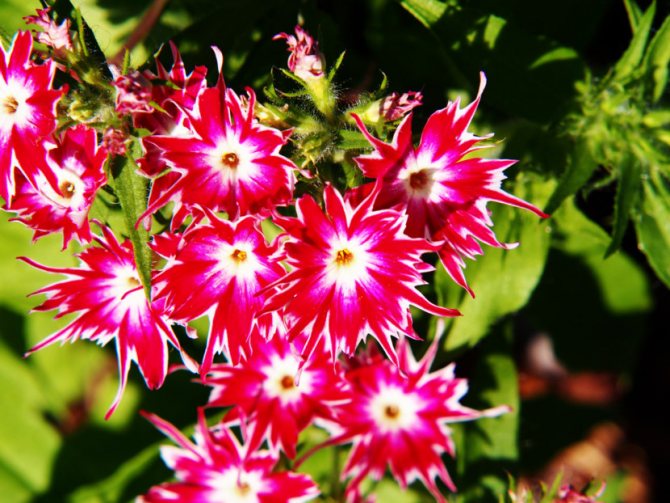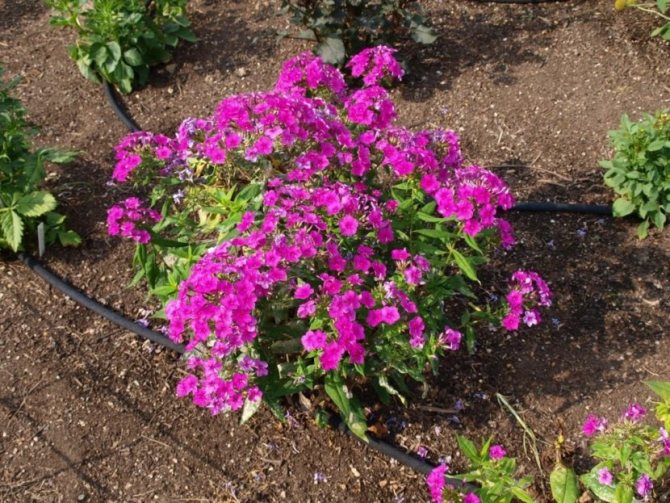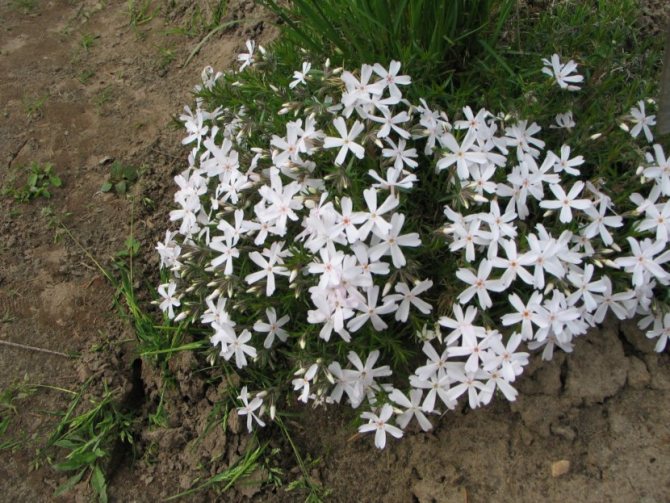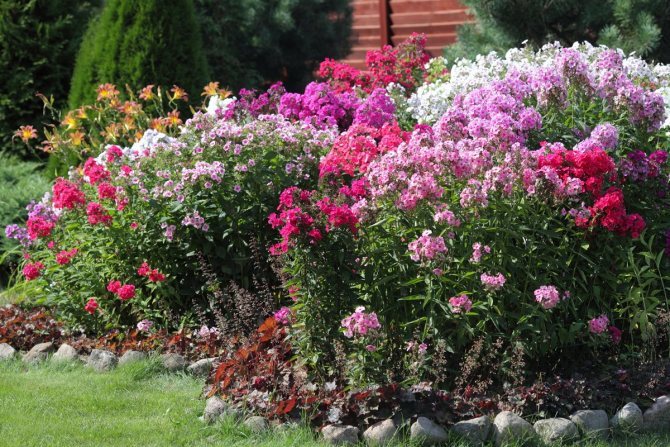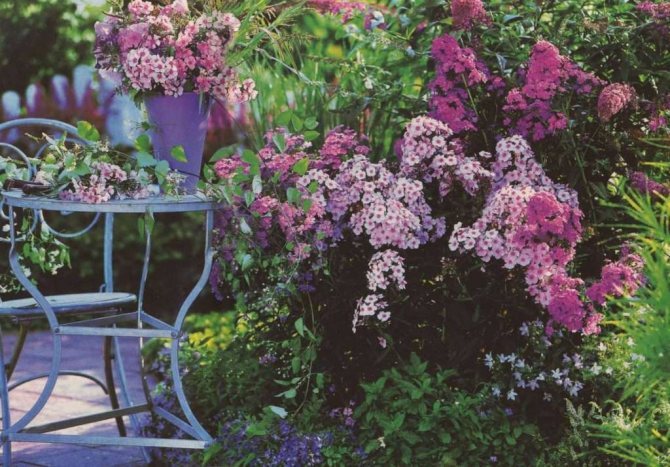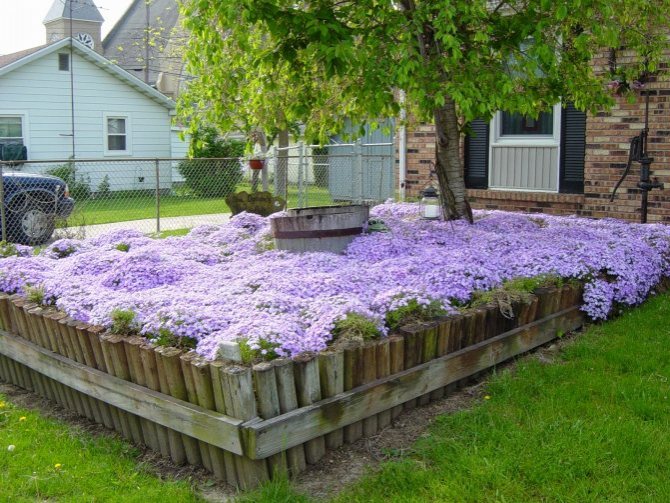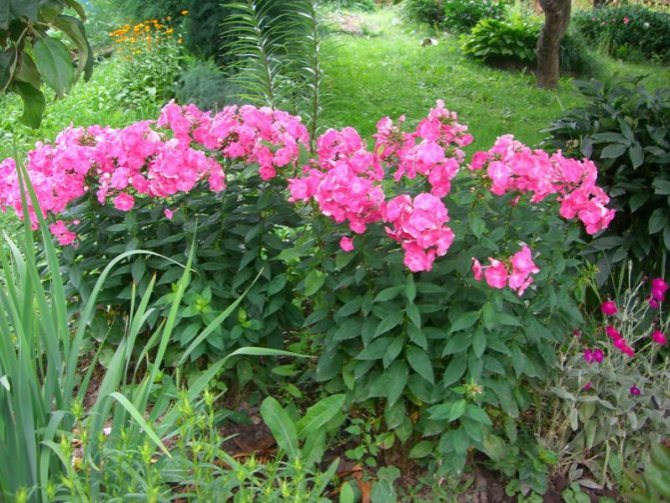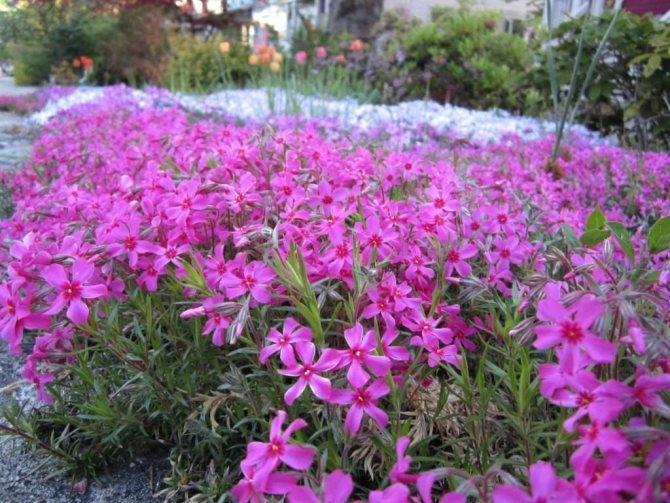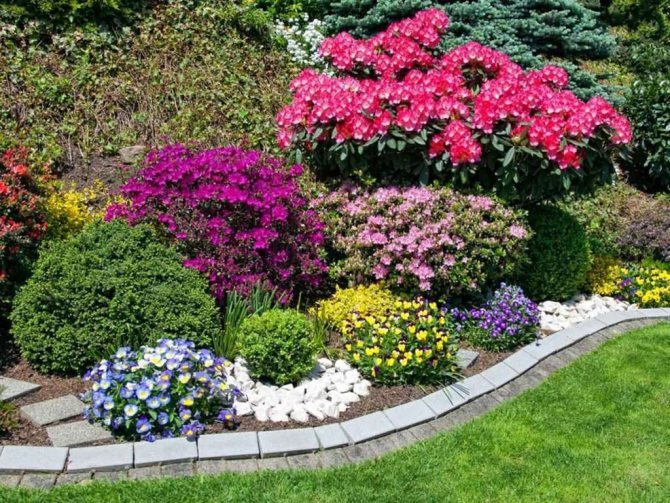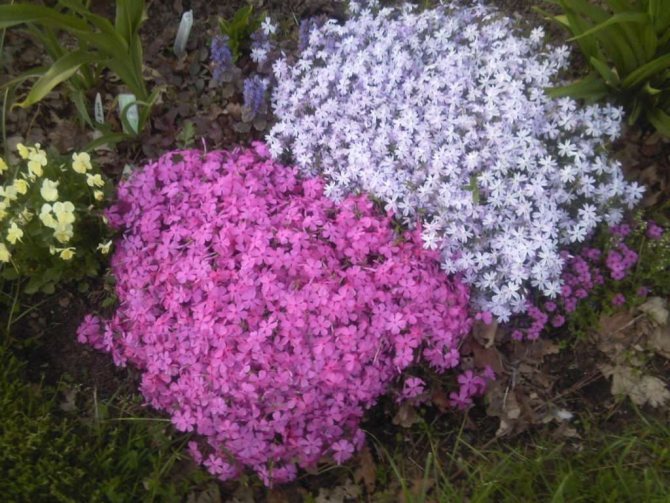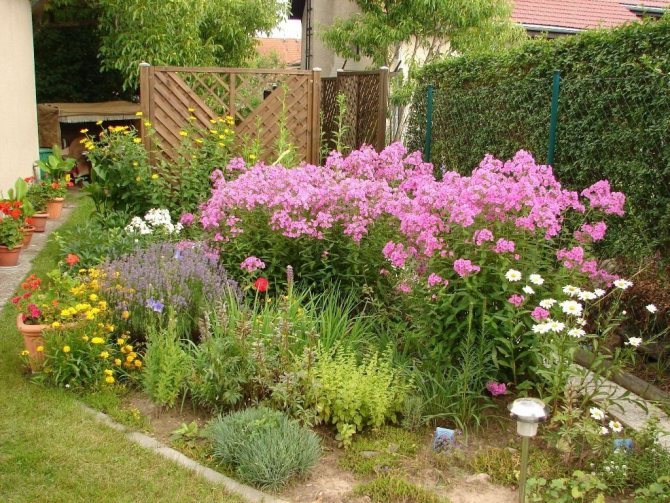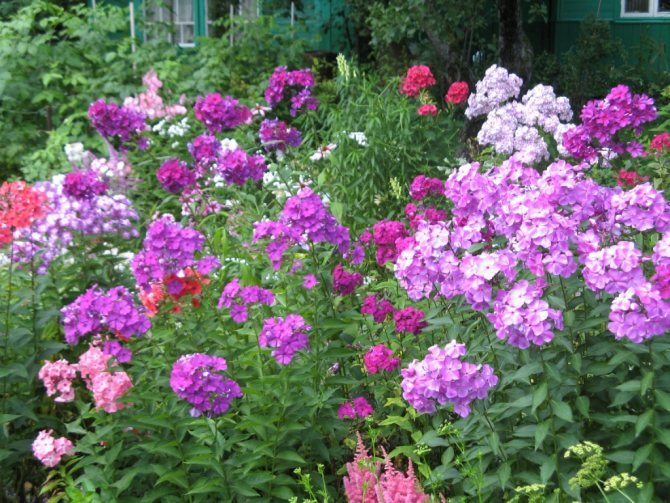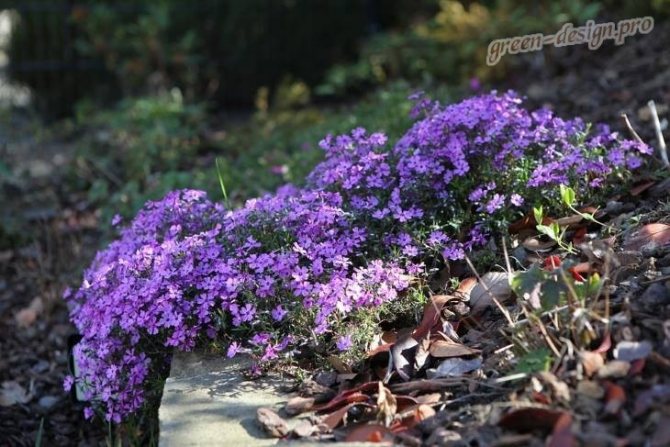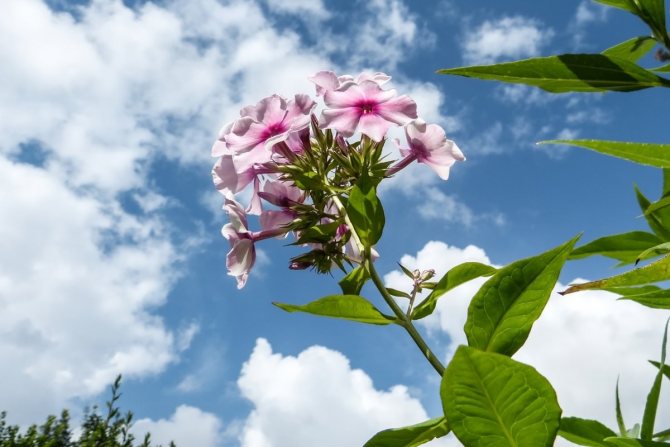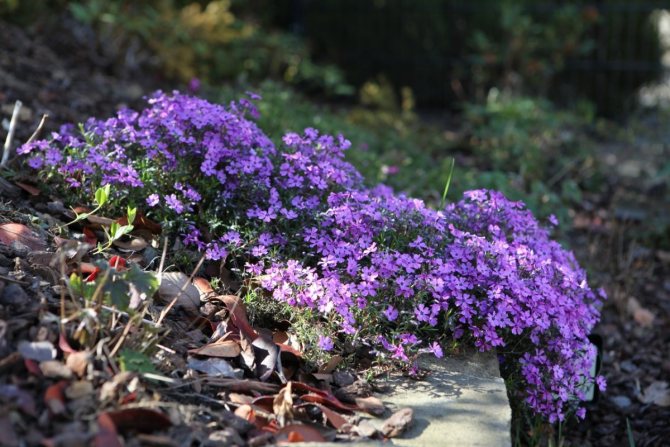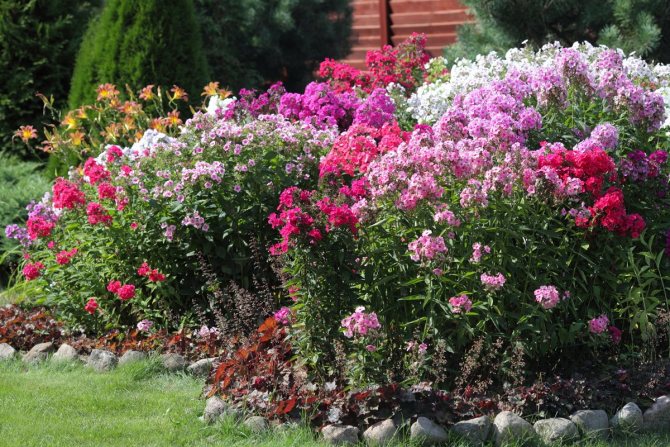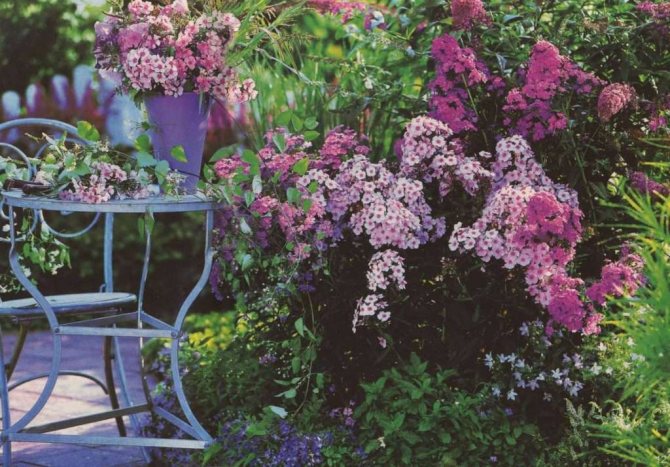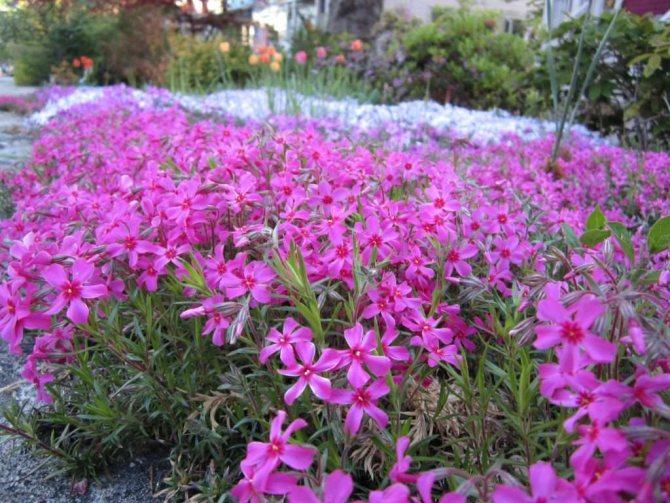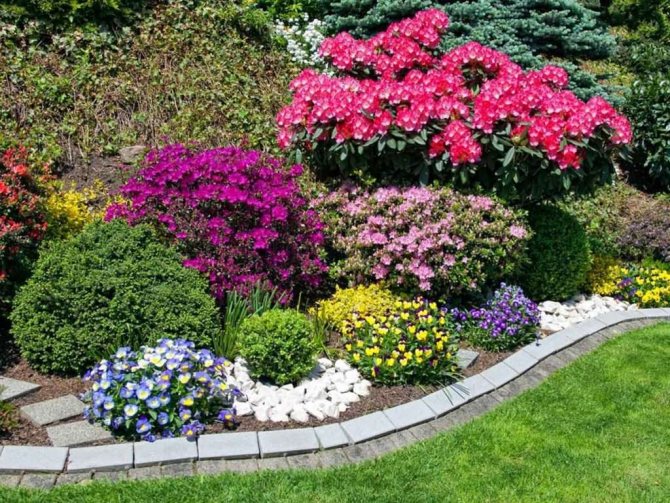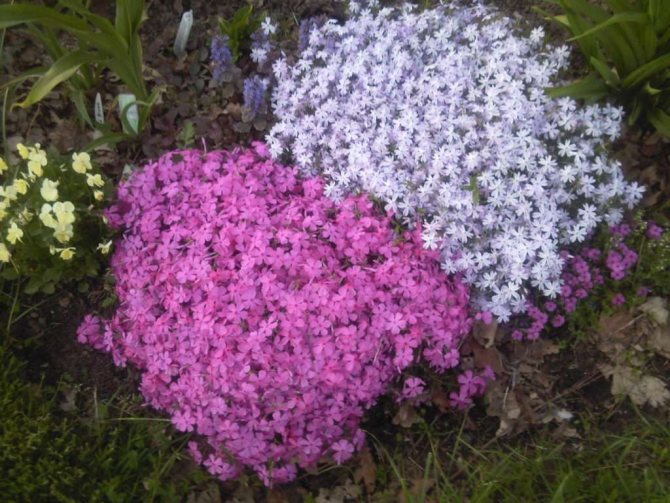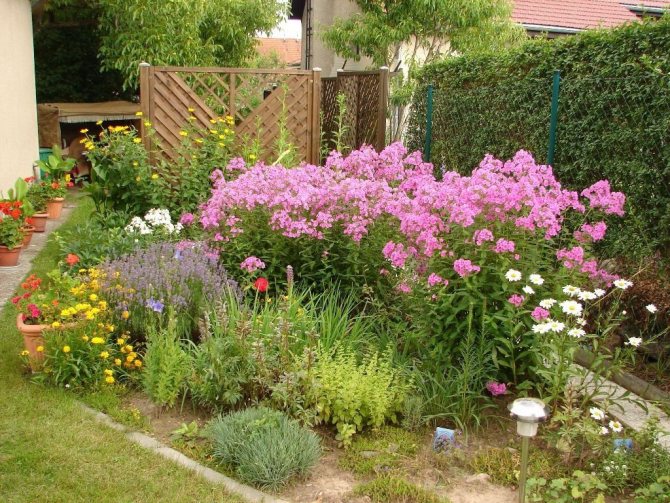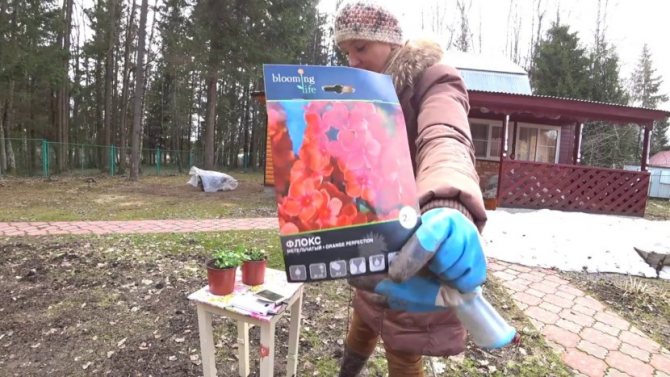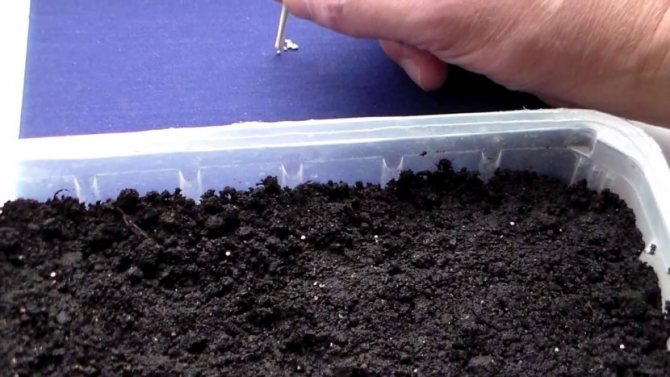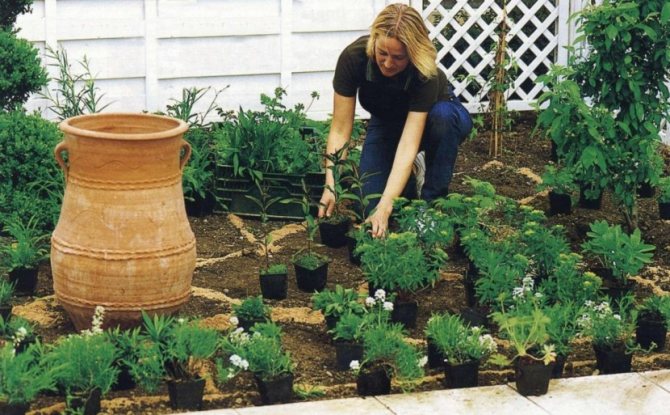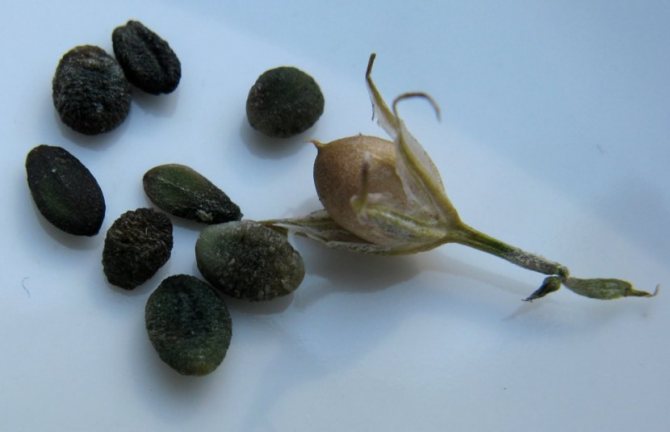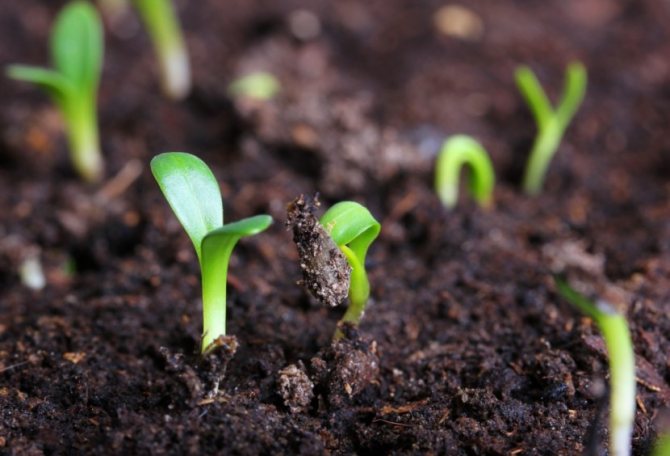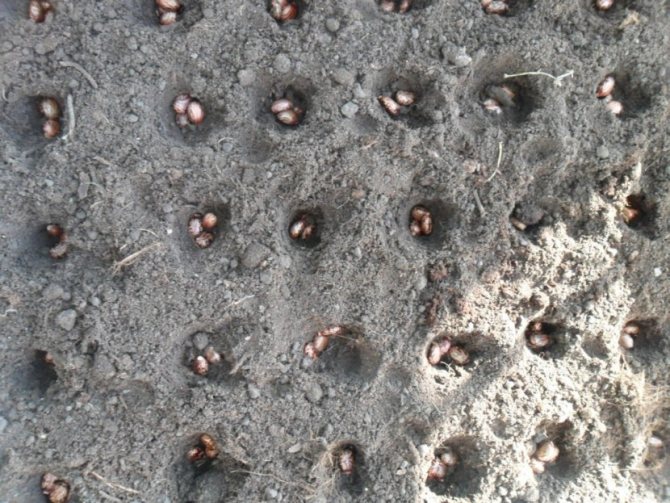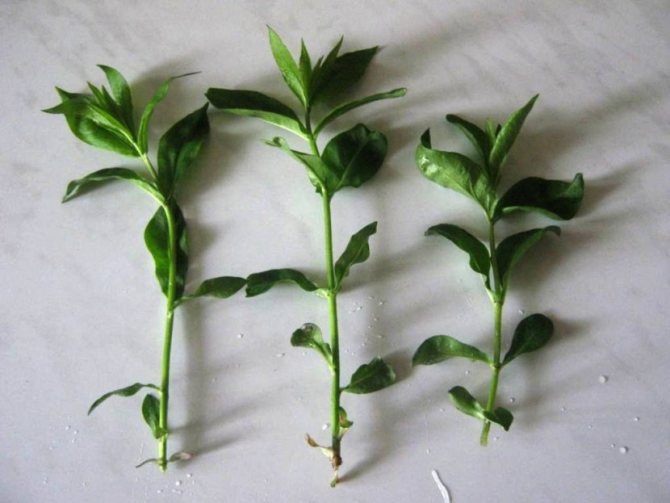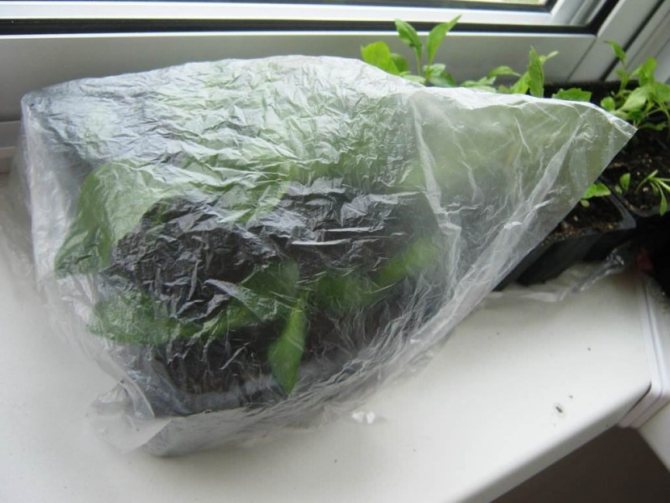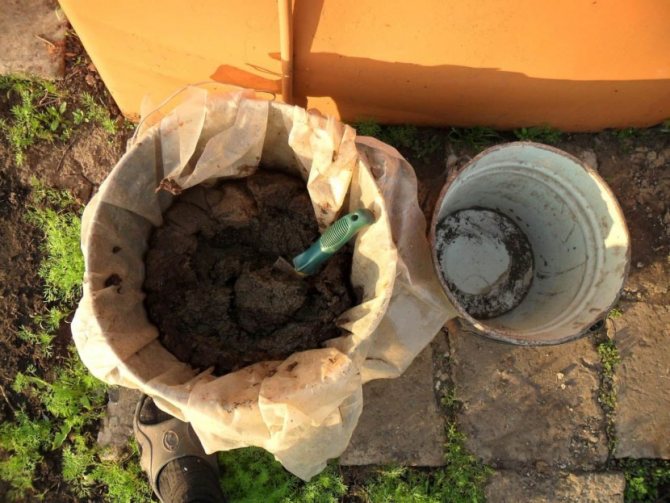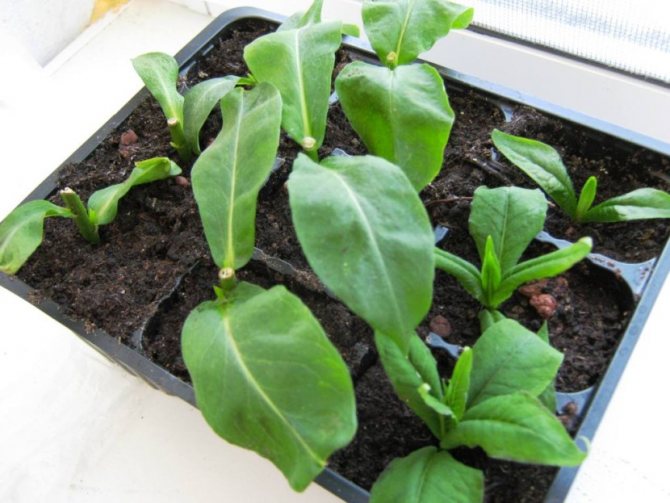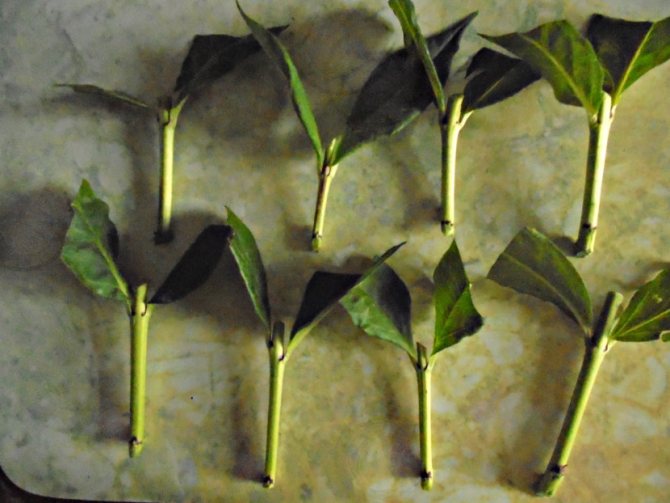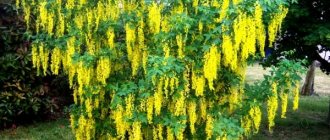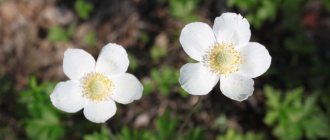Phlox are amazing plants that impress with their abundant flowering and variety of colors. Nevertheless, many myths are associated with their cultivation. Inexperienced growers claim that flowers very often get sick and lose their decorative effect at the end of summer. That is why they are used only in the background of flower beds.
In fact, phloxes have a flawless appearance.
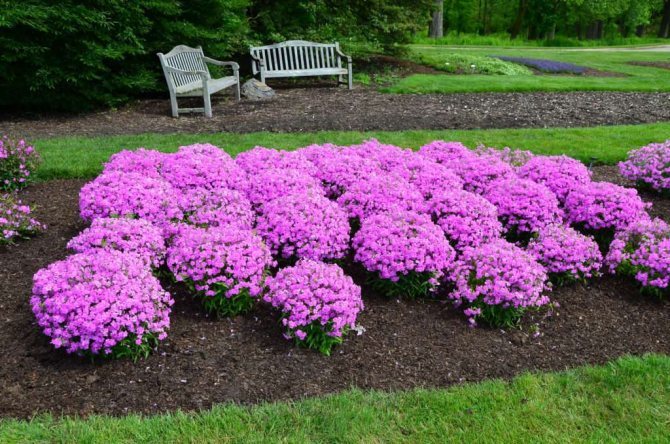
But for this, plants need to create comfortable conditions for development. This is proved by the fact that designers very often use them when creating unique landscapes and exclusive garden designs.
Application in landscape design
Phloxes in the garden can be combined with any other flowers. They can make the perfect composition with flowering and fruiting plants, as well as evergreen shrubs. Suitable for decorating alpine slides, framing decorative ponds. From this shrub, you can make a full-fledged hedge or divide the site into zones. Due to the fact that the roots of these flowers are not located deeply, they can be planted in flowerpots or pots, thereby decorating individual sections of buildings.
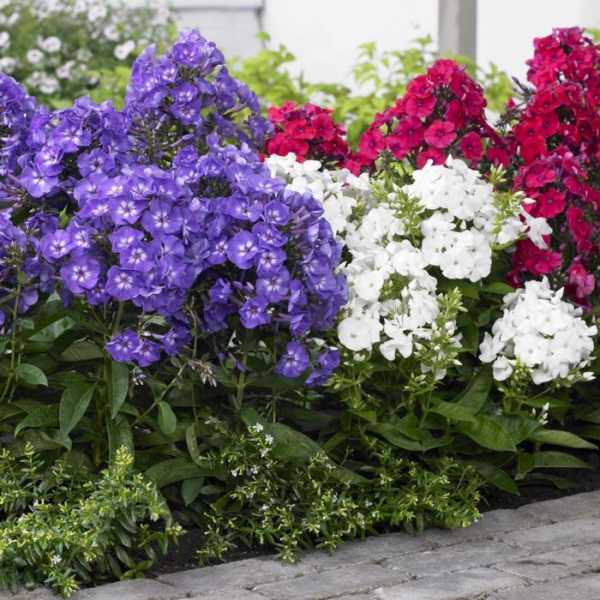

Flower garden of paniculate phlox
There are about a thousand varieties of phlox around the world. They are varied in shades, shrub height and growth and flowering characteristics. If you correctly combine varieties, you can create a unique composition that can delight with flowering throughout almost the entire season.
Important! All the features of growing this plant should be taken into account before planting phlox beautifully. Then any city house and summer cottage will be decorated with a lush, fragrant plant in the summer.
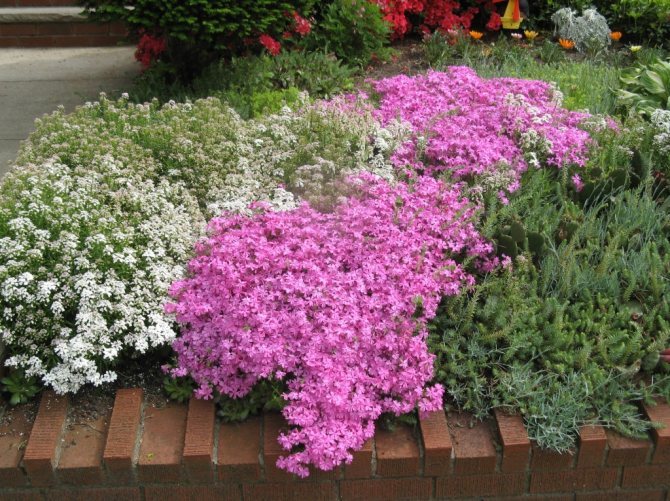

Ground covering phlox in the decoration of the rock garden
What phlox are combined with
When planning a composition in the garden with the participation of phloxes, you need to select neighbors for them who will be satisfied with similar growing conditions:
- sunny or semi-shaded area, ideally with diffused light;
- the location of the planting on a small hill, excluding stagnation of water at the roots;
- providing an abundant amount of moisture;
- loose sandy or loamy soil enriched with peat or humus;
- slightly acidic or neutral soil reaction.
It is also important to take into account that phlox roots are powerful and branched, located close to the surface.
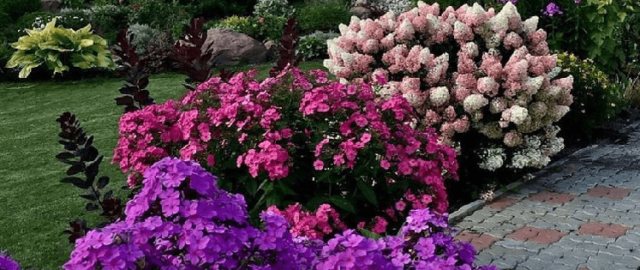

The structure of the root system of companion plants should be such as to exclude “competition” for moisture and nutrients within the framework of planting.
What flowers can be planted next to phlox
Now it is worth dwelling in more detail on those flowers and ornamental plants with which phloxes in the garden are most interestingly combined. A selection of photos will help to imagine how such compositions look in the design of the site.
Can phloxes of different colors be planted next to
One of the simplest and at the same time effective solutions is a combination of several varieties of phlox of different types, sizes and colors on a flower bed. When choosing which ones to plant next to each other, you need to pay attention to other details:
- how the flowers are colored - monotonous or combine two or more colors;
- how the shades are distributed - in the form of spots, stripes, edging;
- color intensity - gentle or, on the contrary, saturated, bright gamut;
- the shape of the petals is even, corrugated or wavy.
Important! The color of flowers of many popular varieties can be perceived differently depending on the time of day, the angle of incidence of light and its intensity.
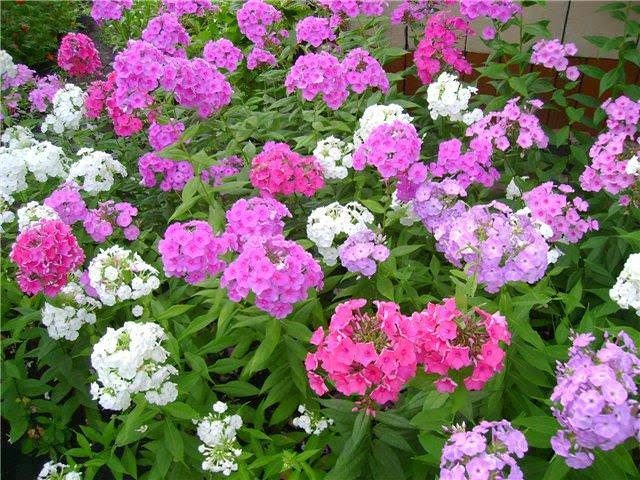

Experienced florists recommend avoiding sharp contrasts of varieties, trying to combine the palette harmoniously
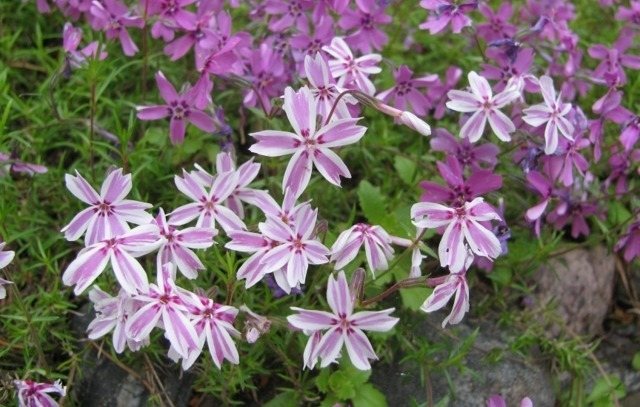

You can also give preference to one color, combining its shades and tones in various options.
Examples of the use of phlox in the landscape design of a summer cottage are presented in the photo:
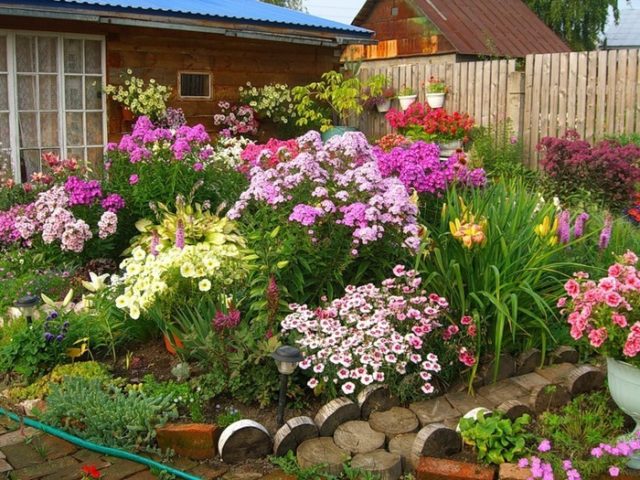

By placing high or medium-sized varieties in the center of the composition, and bringing low ones to the foreground, you can easily arrange a beautiful ceremonial flower garden
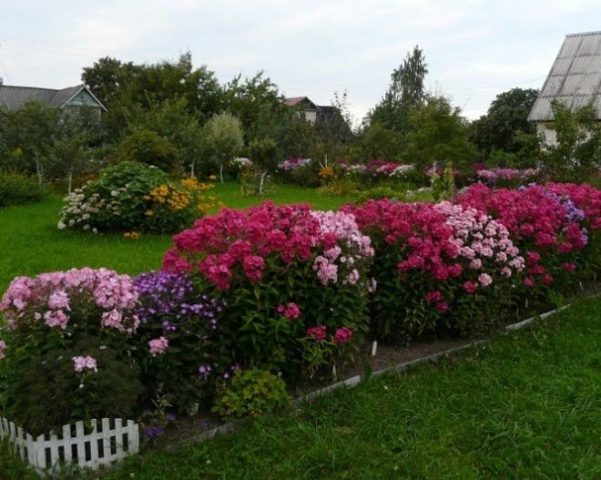

On a green lawn, a bright area made of monochromatic varieties of phlox of pink, red, white or purple flowers, or their combination, looks very impressive


Having planted strips of ground cover varieties nearby, it is easy to get a bright motley "carpet" of any shape and color
Phlox in garden design
Perennial phloxes look great in open areas, and they can also be planted on the lawns in front of the cottage. Low-growing phloxes are in perfect harmony with stones. They can be planted along the paths. Check out some photos illustrating the use of phlox in landscape design.
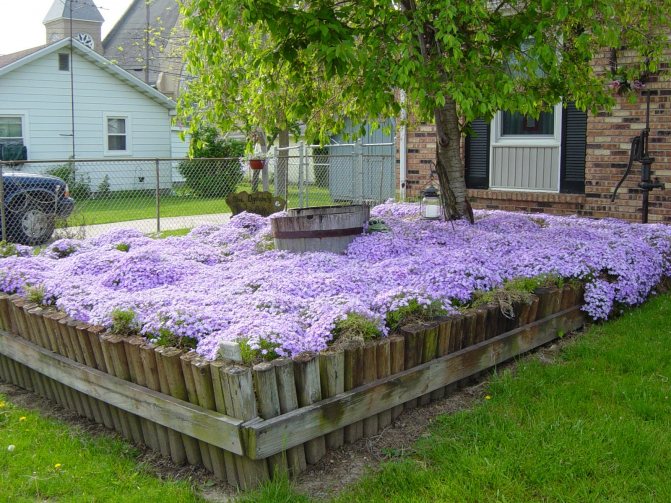

Composition with phlox
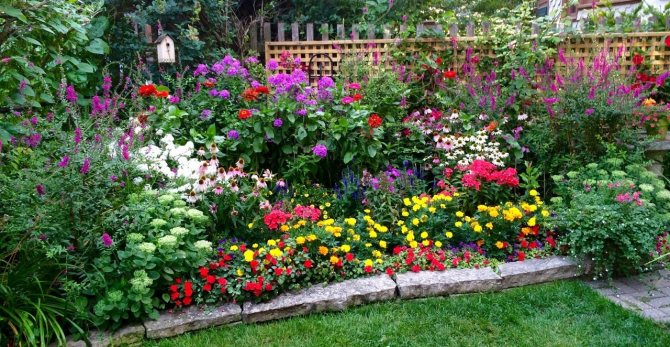

Phlox in a flower bed


Phlox carpet
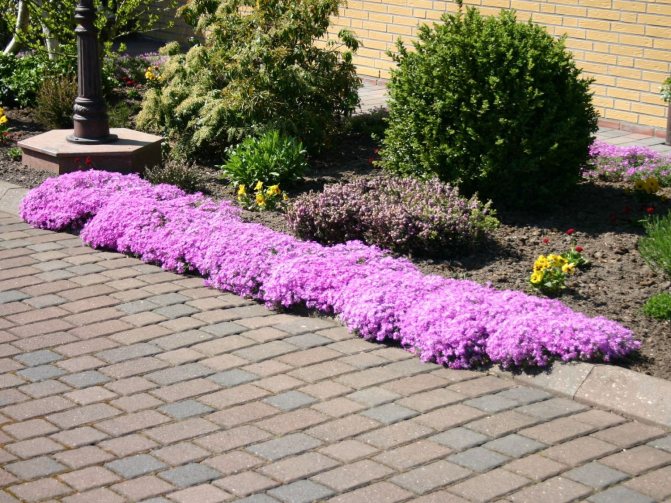

Douglas phloxes along the walkway
Place for a flower bed
When deciding on a place for planting plants for permanent residence, one should remember not only how phloxes will look on the site. It is also important to think about protecting the plants from direct sunlight and drafts and what to plant next to phlox.
Why rhododendron does not bloom outdoors in the garden: what to do
The best place to plant would be a piece of land where the sun hits in the morning. At this time, its rays are not too hot, this will avoid burns on the leaves and fading of the color of the buds. In the afternoon, the light falling on the shrub should be diffused.
Important! It is also necessary that the flowers are protected as much as possible from gusts of wind. Therefore, if they are planted in an open space, you need to make sure that tall shrubs or trees grow at some distance. Their presence will provide light shading and protection from drafts.
Tricks in the garden
To grow colorful inflorescences, there are some planting features. Low shrubs require a distance of at least 40 cm between them, tall ones need a distance of 50 to 70 cm.
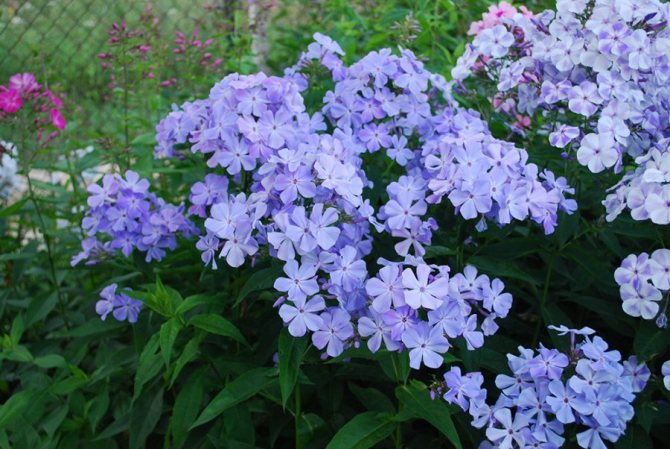

Please note that when they grow, they do not occupy a small area. Think about how to plant the bushes so that the adults do not drown out the young growth.
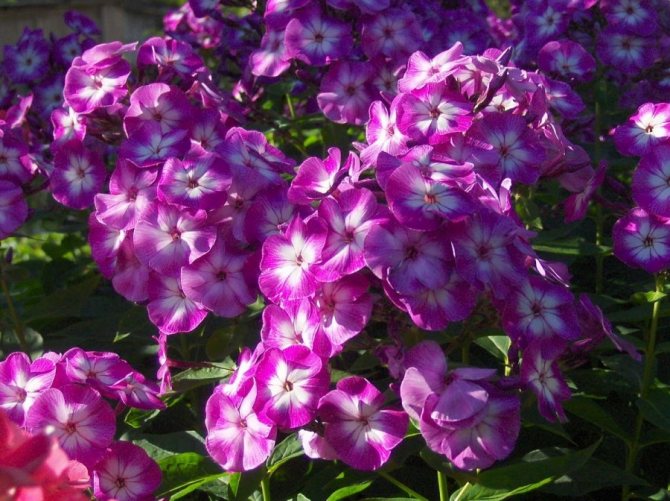

For better growth and high-quality flowering, fertilize with chemical (saltpeter) and natural (chicken droppings, mullein) dressings. Of course, plants need loosening of the soil and timely weeding, weed control.
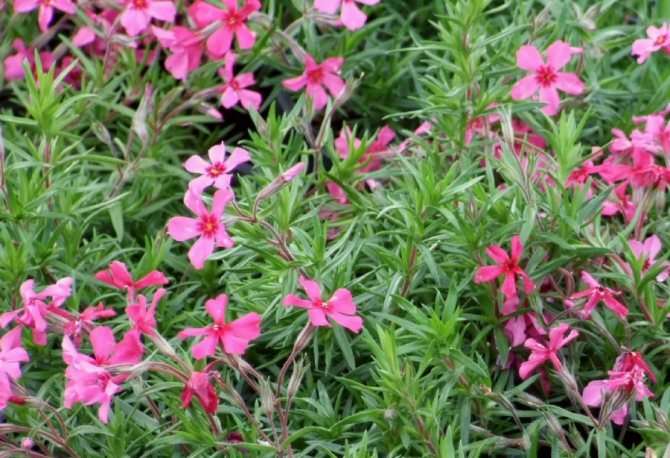

Transplant and reproduction
Phloxes are almost the only perennials that can be replanted even during flowering. You can dig it up and transplant it with a lump of earth to another place, they will take root there perfectly. They multiply quickly and get used to new soil very well. In a couple of years, you can grow huge flower beds with beautiful flowering plants.
They also reproduce very easily. Here are the main ways:
- Division of the bush. This method is the most common, because every three years the bushes must be separated in any case so that the flowering of the plant does not deteriorate: if the plant grows strongly, then the flowering will be weak.


Dividing the bush - Root offspring. This will require the remains of large roots.You need to carefully cut them into several cuttings, the length of which should be 7 centimeters, then you can plant. Next year, you can watch how new plants grow from these cuttings.
- Seeds. This method is little used by amateur gardeners. It is mainly used for breeding.
- Green cuttings. This procedure is recommended to be performed with the arrival of June from green shoots until the period when they begin to bloom. (If they begin to bloom, they become woody and unsuitable for grafting.) For reproduction, you will need to cut the stem of a suitable young shoot into two or three parts, and leave two pairs of leaves on each part. Such cuttings can be rooted in a greenhouse bed, which is covered with a film along prepared wire arcs. For good reproduction, you need to pour sand on the surface with a layer of three centimeters. Planting depth should be no more than three centimeters. Once planted, they need to be watered well, shaded and watered then daily. The rooting period is approximately 2 weeks. Once they have taken root, you can plant them in a permanent open area.


Green cuttings - Layers. If a phlox bush is covered with earth high, after a while roots will begin to appear on the covered stems. When they develop, they are freed from the ground, cut off the stems with roots and planted in the ground.
Subulate phlox
This type of undersized phlox, ground cover, is most often used in compositions of rockeries and alpine slides.
The main signs are:
- perennial;
- height up to 20 cm;
- narrow needle-like leaves, up to 2 cm. Remain green almost until frost;
- on a low stem, one, rarely 2.3 inflorescences;
- flowering: mid-May, end of June, repeated, August-September.
These flowers create a beautiful bright rug in a wide variety of colors and shades. A spectrum of blue, lilac, raspberry pink and white tones prevails.
Interesting. With a variety of colors, among all varieties, they could not remove yellow phlox.
Varieties with names:
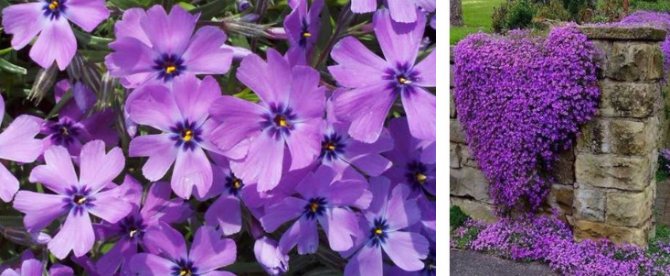

Flowers Phlox subulata "Purple Beauty", Purple Beauty.
A perennial plant that loves light. Flowers, from rich to pale lilac, purple. Blooms in May, June. If you cut the tops, it is possible to re-bloom closer to autumn. The height of the bush is up to 17 cm.
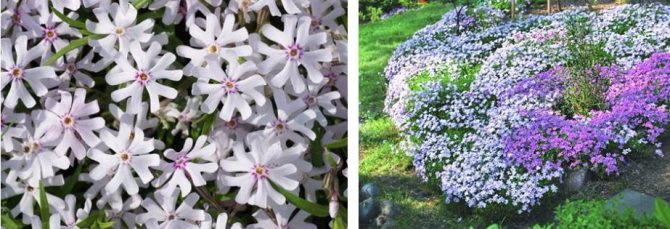

Subulate phlox bifida "Petticoat", Petticoat.
The bifurcated white flower gives it a moth-like appearance. Stem height up to 20 cm, loves well-drained soil with fine pebbles and sand, for which it is also called sandy. Star flowers exude a delicate aroma. It tolerates frosts up to 20 degrees. Inflorescences are pale blue, purple, white and purple. Blooms in May-June. The middle is highlighted with blotches of a different shade.
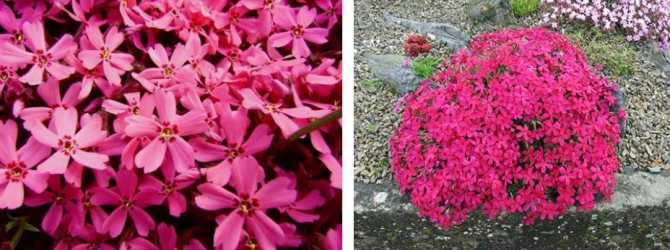

Phlox "Red Wings", Red Wings, Krasnye Krylia.
Intensely pink inflorescences will decorate any rockery and alpine slide. The bush is up to 20 cm high. It tolerates frost and heat well. Loves drainage soils. Unpretentious enough. Flowering is accompanied by a pleasant aroma, like most of this species, blooms in May-June, again in autumn.
Distinctive characteristics of subulate phlox:
- tolerate frost and heat well;
- love light areas;
- early flowering. After flowering, the tops are cut off for re-flowering in the fall and the formation of new inflorescences;
- like drainage soils mixed with turf and sand;
- once every five years, the bushes are divided and rejuvenated;
- need 2 single feeding in spring and summer;
- reproduce by dividing the bush and lateral processes.
These varieties were bred in foreign nurseries and are not represented by domestic analogues.
The most beautiful types of phlox
Annual phlox: planting and care
It is impossible to say with certainty - this view is the best. The tastes of each person are individual, and there are many varieties and varieties of these flowers.In order to create a flower garden that meets all the needs of a gardener, you need to understand the variations of phlox and how they differ.
These plants are classified as perennial and annual. Most of them are capable of growing up to 10-15 years. Only one variety is considered annuals - Drummond's phlox. Some breeders believe that this particular variety is the basis for all other plant varieties.
Phloxes are also subdivided into subulate, ground cover, Canadian and paniculate. They differ in the general structure of the trunk and leaves. Subulate ground cover phlox for the most part spread along the ground, rising in height no more than half a meter.
Canadian phlox are short shrubs. From a distance, it seems that they cover all of their territory. In fact, it is an ornamental shrub, from 25 to 45 cm high. In structure, it resembles a paniculate phlox, but in much reduced proportions.
Paniculate phlox grow vertically upward, if the trunk is bent to the side, then this shoot is considered defective and must be cut. In height, this type of phlox can reach 1.5 m. The leaves of this variety are large, elongated, dense, with a pointed end. They have a rich dark green color. The length can be up to 15 cm.
These flowers also differ in the structure of the flowers themselves, the shape and fullness of the inflorescences. The flowers are usually tubular and funnel-shaped. Consist of 5 petals, 1 - 3 pistils and 5 stamens. The shape of the inflorescences can be spherical or pyramidal. In one inflorescence, from 50 to 100 flowers are collected, up to 5 cm in diameter. They can be located either tightly to each other, or be at some distance.
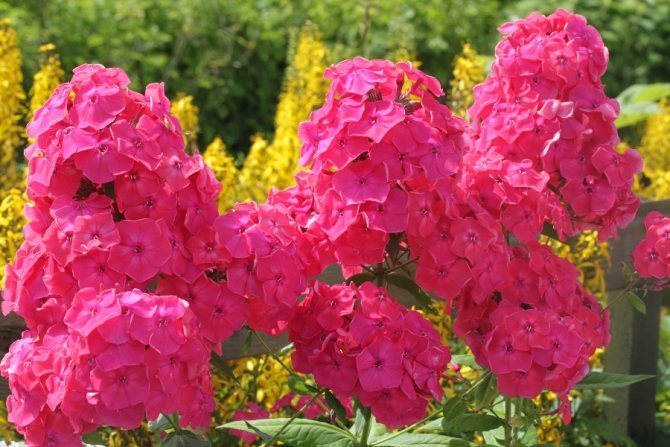

Pyramidal inflorescence
Flower petals vary in shape. Edges can be pointed, smooth, rounded or terry. The petals are located at an angle of 90 ° to the tubular core of the flower. The cup, assembled from petals, also takes various forms:
- wheel-shaped;
- saucer;
- notched;
- star-shaped;
- dissected.
The flowering time of different varieties is different. Identify early flowering and late flowering. Early blooming flowers delight with flowering from May to mid-July, late ones can bloom from July to October. The average flowering time of one plant is up to 30 days. Some varieties are capable of blooming twice a season.
Important! After the inflorescence has withered, it must be cut off. This will ensure healthy growth for the shrub and lengthen the flowering period of the remaining flowers.
Another important factor in the difference between varieties is the variegation of some plant varieties. Phlox leaves in these varieties are colored with a border of a contrasting shade, thereby giving the flowers freshness and juiciness. The border can be lighter in relation to the sheet, or, on the contrary, much darker. Its thickness varies from a few millimeters to several centimeters. Moreover, on the inner side of the frame, there are periodic smudges directed towards the center of the sheet.
Spring and autumn are the most suitable seasons for planting phlox. It is better to plant flowers to create a flower bed according to the scheme. It can be drawn by hand or kept in mind.
Features of varieties, where to order
The varietal variety of these flowers is so great that you can separately arrange a phloxarium, which will bloom until frost.
Phloxes are quite unpretentious, but in order for them to bloom beautifully and for a long time, they need care.
Note. Correct and timely care promotes long, abundant and beautiful flowering.
Care Tips:
- love loose, neutral and slightly acidic soils;
- fertilizing with nitrogenous, potash and organic fertilizers is necessary (up to 6 times);
- it is necessary to water not on the foliage or at the root, but around the bush, heated in the sun with water;
- all phloxes, except for splayed ones, do not tolerate shade well;
- despite the fact that they can withstand frosty winters, it is better to mulch the roots in late autumn;
- the optimal time for planting is autumn;
- it is better to plant by layering from a bush with roots. In this case, the roots are slightly pruned for rejuvenation and the old ones are removed;
- hygrophilous enough, you need to make sure that the soil does not dry out;
- to improve the quality of the inflorescence, the tops are cut off after the end of the flowering season.
Compliance with these simple, in general, traditional rules will allow you to admire the flowering of these beautiful plants all summer long.
Where can I buy seedlings and seeds
Each crop has its own amateurs who specialize in growing specific plants. Phlox could not leave the gardeners indifferent. It is this kind of enthusiasts who distribute seeds and seedlings. Moreover, the owners of the phloxarium will give you advice, reveal the secrets of care. They are touching about their planting material, so they will be interested in how it took root and advise you. Seedlings purchased from local gardeners are more adapted to local conditions.
The second option, flower exhibitions, which take place annually in spring and autumn.
Third way, specialty stores. But there is a caveat here. Many retail outlets use foreign material. Not all varieties take root with us at once and endure stress from changing growing conditions.
And of course the Internet. You can find specialized sites, order seedlings and seeds.
Remember. Do not despair if a new variety, especially foreign selection, does not take root immediately. Try to save at least some of the planting material. Consult with amateurs, you can use the forum of gardeners. The plant needs time to get used to, and your anxious attention.
Pruning phlox in the fall
Many novice gardeners are wondering whether phlox should be pruned for the winter? If we are talking about perennial crops, experts recommend preparing phloxes for winter correctly and pruning.
How to prune phlox for the winter? The procedure is carried out in the fall, when the flowering ends, from about September 20 to October 31, after the transfer of accumulated nutrients from the green part of the plants to the rhizome. The work should be completed before the onset of persistent cold weather.
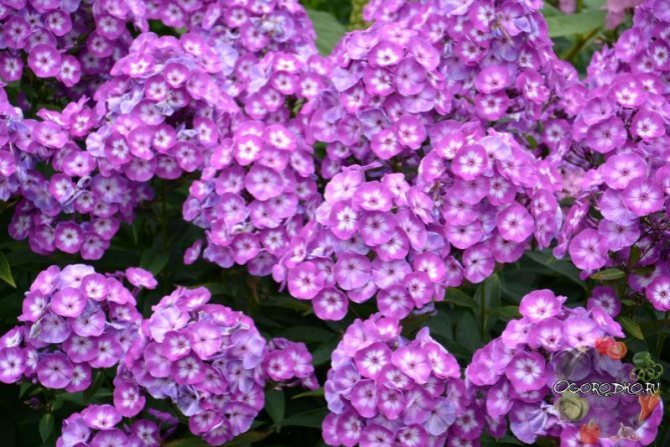

For example, in the southern regions and in the Kuban, phlox pruning can be carried out a little later. Take into account the climatic characteristics of the growing region, but be sure to wait until the plant has bloomed, only then proceed with the surgical intervention.
Pruning phlox for the winter is carried out when it gets colder outside. Many growers leave small stumps (10-15 cm), some completely cut off the stem, almost level with the ground.
The experience of experienced gardeners shows that complete pruning reduces the risk of disease and the spread of infections on phlox. After cutting, it is recommended to treat the soil around it with fungicidal preparations. After a week, the space is sprinkled with wood ash, then mulched with peat chips.
Phlox classification
Phlox is characterized by a wide variety. More than six dozen plants are united in this genus. But, despite the multiplicity and closeness of many species in terms of their decorative characteristics, it is very easy to navigate the classification. After all, phloxes are grouped according to the shape of growth, which allows you to immediately find a list of candidates for completing the set decorative task. Wild species phlox are not used in gardening: these perennials are represented by decorative forms, varieties and hybrids.
The main phlox classification divides plants into only three groups:
- Creeping phlox, including all types and hybrid forms of ground cover phlox, forming cushions and turf.
- An intermediate category, or loose-sod phlox, with vegetative creeping stems in a loose sod, from which straight-growing flowering shoots rise upward.
- Shrub phlox, combining low, medium and tall species, considered the most common of all phlox.
Each of these groups differs not only in size and structural features, but also in cultivation techniques. Ground cover phlox require different conditions and different care than bush phlox.
Legendary Phlox paniculata and splayed, Arendsa and the only one-year-old Drummond phlox, columnar and subulate are the most common types of phlox. But among the plants there are other varieties that are also capable of becoming a true decoration of the garden.
The difference in flowering time between creeping and bush phlox allows all phlox to be divided into two categories according to flowering time:
- Spring-blooming phloxes that create vibrantly colored carpets in gardens where the early-blooming season is just beginning.
- Phlox of summer-autumn flowering, delighting throughout the summer, when choosing modern varieties, they are distinguished by an amazing duration and variety of flowering. This group is sometimes divided into phlox of medium and late flowering. The former delight with their inflorescences in June, and the latter - from July to September.
Effective combination with catnip
Although phlox are combined with many types of plants, they look most advantageous when catnip grows next to them. Small spikelets of catnip, of a light lilac color, favorably set off almost all types of phlox. This combination gives the flower bed fullness and harmony. In addition, the essential oil content of catnip helps repel some pests.
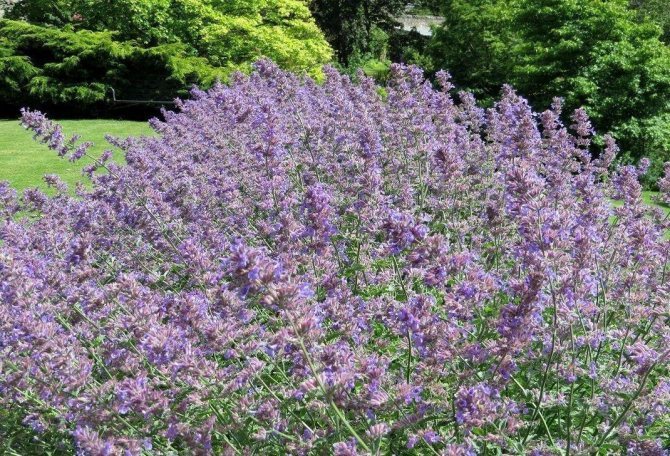

Cat mint
Annual chamomile helps to further enhance the effectiveness of the above-described composition. Nivyanik has a white color and short stature, so it will not overlap the beauty of phlox. But against the background of daisies, the bright colors of perennials will become more juicy and saturated.
Phlox varieties by shades with photos and names
There are many other herbaceous plants with different shades. There are all kinds of phlox flowers, but we will tell you about the shade of two or three leading varieties of this or that color range.
Blue and blue varieties
Let's start with the blue and blue varieties of phlox. In fact, they are purple in color with varying gradations. They appear blue with a certain slope and lighting, and this gives some unusual charm to the flowers.
The Dragon
Take into account! "Dragon" loves diffused lighting, as it is not resistant to scorching sunlight. He also does not tolerate drafts, does not get along under the crown of a tree, on the slope and on the north side of the plots. A suitable soil will be fertile, well-moistened, but without moisture stagnation.
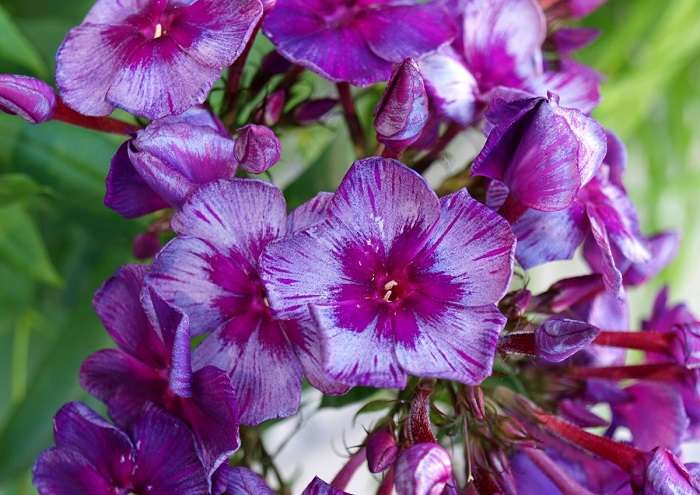

Before planting this species, dig up the area to a depth of 35 centimeters. If the soil is sandy, moisten it with humus, if black soil, drain it. Caring for your phlox is not at all burdensome, just water it regularly and fertilize it with minerals.
Cinderella
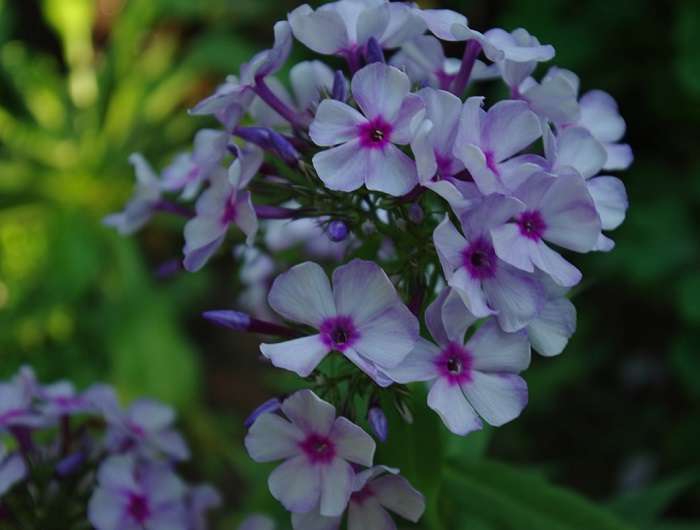

Low-growing category of phlox. Plant height from forty to fifty centimeters. The diameter of the flower is about 3.5 cm, the inflorescence is bushy, pyramidal, large. It blooms profusely from the end of August and continues until mid-September. The bush is strong and fast growing. Great for the foreground of a flower garden.
Pink varieties
Pink perennials will add elegance and tenderness to your flower garden.
Pearl
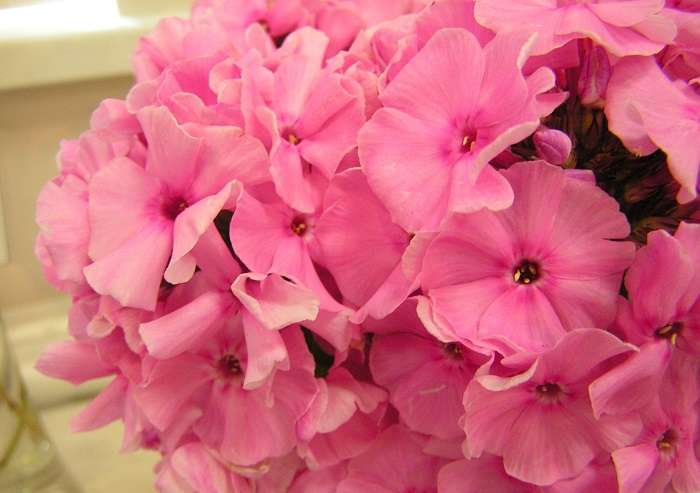

The perennial grows up to 60 cm, and its flowers spread out to 3.5 - 4 cm wide. The flowering period is late. The flower is hygrophilous, but does not tolerate stagnant water. Feed three times per season for more bloom. Do not loosen the ground around the perennial, you can accidentally touch the root system. This, incidentally, applies to all types.
Zinusha
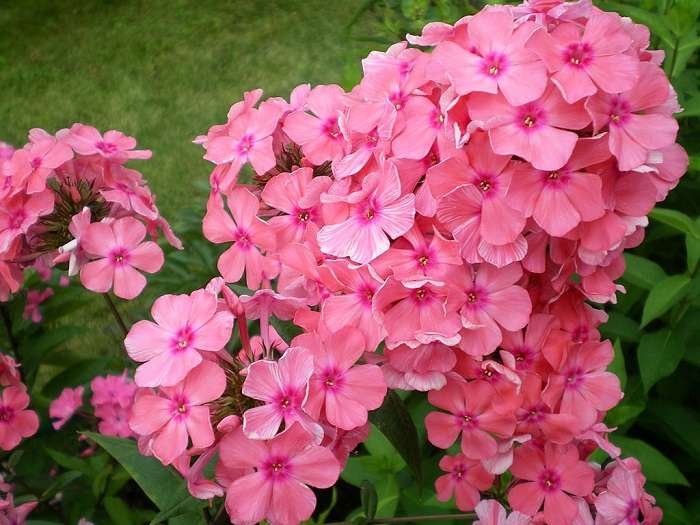

Light, salmon pink color with a small carmine ring. The inflorescence is oval-conical, very large, dense. The bush is compact, durable. remember, that these plantings have the ability to propagate by cuttings, so if you dug it out from one place and transplanted it to another, then it often appears in the same place after a year.
Red varieties
Red phlox cultivars add brightness with their rich palette of colors. The most non-standard and colorful ones are described below.
Manon
It was discovered by Bedinghaus in the 20th century. It is an erect, strong, well-growing bush, the height of which varies between 75 - 85 cm. To extend its flowering for 20 days, you need to remove the peduncle, as a result of which it will give side shoots from the axils of the foliage.
Gaganov's favorite
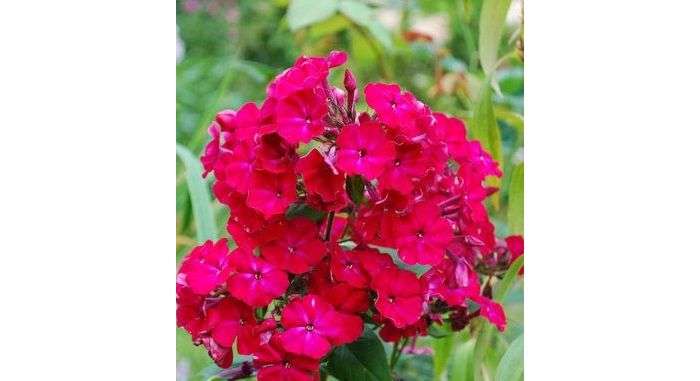

The height of the perennial reaches 70 cm. Cherry, rich, bright color. Velvet structure of the petals. Sunfast. The shrub looks harmonious and durable. It does not grow quickly, it is demanding on growing conditions. A kind of unique charm, absolutely recognizable.
Lilies and phloxes in one flowerbed
The structure of the lily visually resembles phlox shoots. The height of the plants is approximately the same. Together they look harmonious only if they pursue a certain design goal. It will not work to give a separate charm to paniculate phlox in a lily. Nevertheless, you can make a wonderful composition of the daylily and ground cover phlox. Dwarf splayed varieties will also be great when paired with a tall, stately lily.
Important! When decorating a flower garden, lilies should be planted first, since their bulbs should be deeper.
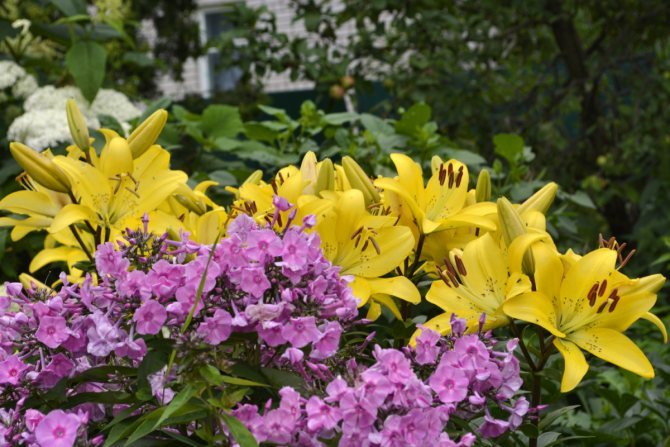

Lily and phlox duet
Phlox subulate and spread apart - what is the difference?
Many inexperienced summer residents often confuse two types of flowers - wide-spread and subulate. Many people think that these are the same phloxes, but this is a mistake. The difference in species is quite obvious - the height of the spreading varieties is up to 30-40 cm, they are not so diverse in colors, they are afraid of severe frosts and snowless winters, they are more demanding on the composition of the soil, the bushes are loose. Subulate phlox in nature can grow on poor soils and bloom well. Experienced summer residents found out that ground cover phlox bloom worse in very fertile soil.
A flower bed of spring perennials
Bulbous plants that begin to bloom in early spring and finish flowering in early June will make the garden bright and festive. The first to bloom are woodlands, snowdrops, mouse hyacinths, crocuses, hyacinths, then they are gradually replaced by tulips, daffodils, hazel grouses, lilies. The scheme of a flower bed of early bulbous perennials can be made in several versions - closer to the edge, plant scaffolds and muscari, further - tulips of different shades.


A beautiful spring flower bed will turn out if you combine small-bulb and large-bulb ones, for example, muscari and double tulips


At the end of spring, irises bloom, amazingly beautiful bulbous flowers. Usually they form an independent flower bed, and if you use irises of different shades, it is difficult to take your eyes off their flowering


Spring splendor of tulips, daffodils and muscari. Islets of tulips and daffodils are planted along the edges of the muscari alley. If there is not enough space in the garden, even small groups of these flowers will transform any garden corner.
If the flower bed is round, tulips framed by delicate fragrant muscari will look beautiful in the center. Tulips and daffodils are well combined, planted both in groups and in the manner of a Moorish lawn. And the lily, as a late flowering bulbous plant, usually perfectly coexists with summer flowers.
Planting a Moorish lawn is an exciting experience. What results can be achieved:
Avoid dense planting of flowers in the flower bed - they need space to form and grow.To fill the free space in the flower bed, you can successfully use ground cover, decorative sawdust and bark. Take care of the flowers, take care of them, and they will cheer you up all summer and for a significant part of autumn, give positive, pure energy of nature and exquisite beauty.
Phlox "paniculata"
This type of plant is considered the most popular among its representatives. The reason for this is the presence of a huge selection of shades. This makes it possible to apply this flower in the preparation of any landscape composition. It is worth noting that it is in this group that there are varieties that were grown by breeders in Europe.
Phlox paniculata: description and characteristics
- the leaves are elongated and can reach 15 centimeters in length;
- the flowers are in the shape of a ball, and their shades are amazing;
- the buds are neat and compact;
- special attention should be paid to the height of the plants; some varieties have small bushes about half a meter and are considered low varieties, others can reach a meter in the stem and are medium varieties; there are also those that reach one and a half meters in length and are considered the tallest;
- the flowering period may also differ depending on the specific variety; there are those that bloom early, at the beginning of summer; there are those who do it in the middle of the summer season; and there are also late species that delight the eye only at the beginning of autumn.
Separately, I would like to talk about the varieties of this type of phlox. There are a large number of them, and they can all be grouped according to the type of inflorescence. So, varieties were bred with white buds. They are especially loved by landscape designers, since these flowers look very beneficial in a company with the green foliage of any plant.
«Eva Foerster»Differs in that it begins to bloom only at the beginning of the autumn season.
«Heaven”, On the contrary, dissolves the buds very early and does it for one and a half months.
«Sea foam
»Starts to release inflorescences in the middle of summer.
«Swan»Also pleases gardeners from the middle of the summer period.
There is another type of inflorescence, which is distinguished by the presence of different shades on the petals.
«Larissa"Is an early phlox variety.
«Blue paradise"And"Margarita»Refers to those that bloom in the middle of summer.
«Lavender david»Buds from mid-summer and ends only in early autumn.
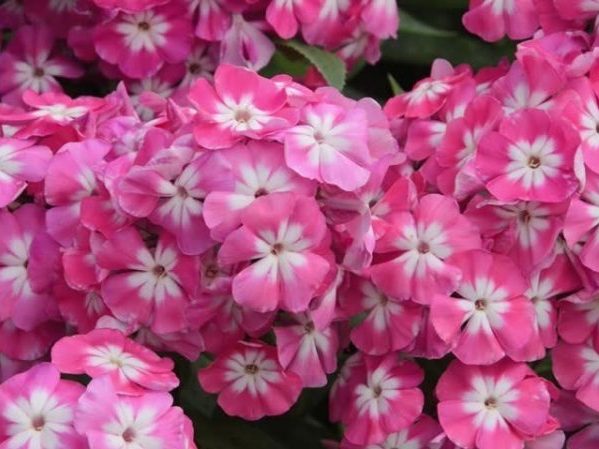

Phlox panicled "Eva Foerster"
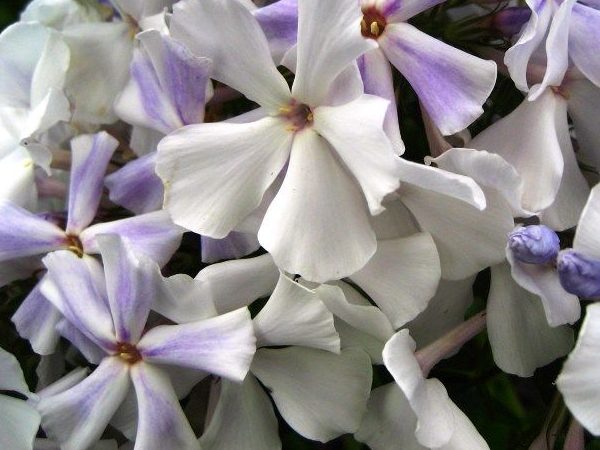

Phlox paniculata "Heaven"
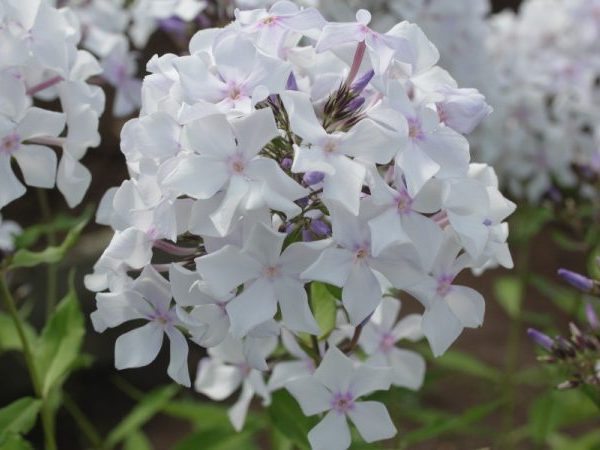

Phlox panicled "Sea foam"
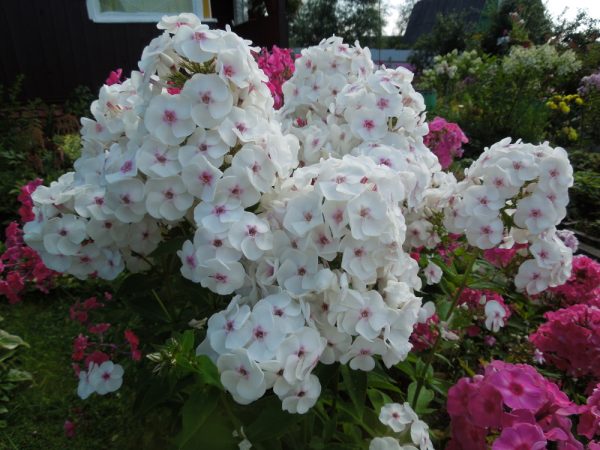

Phlox panicled "Swan"
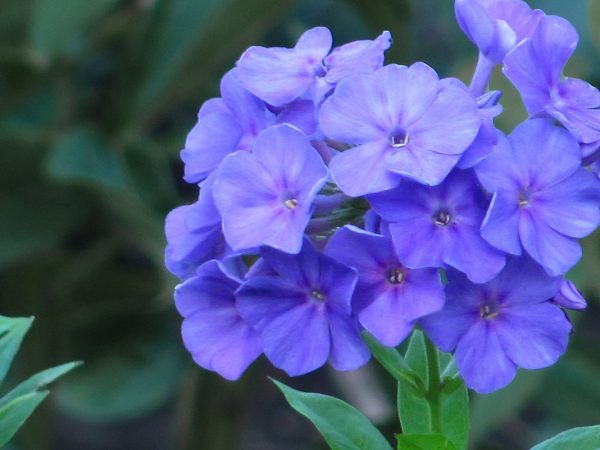

Phlox paniculata "Blue Paradise"
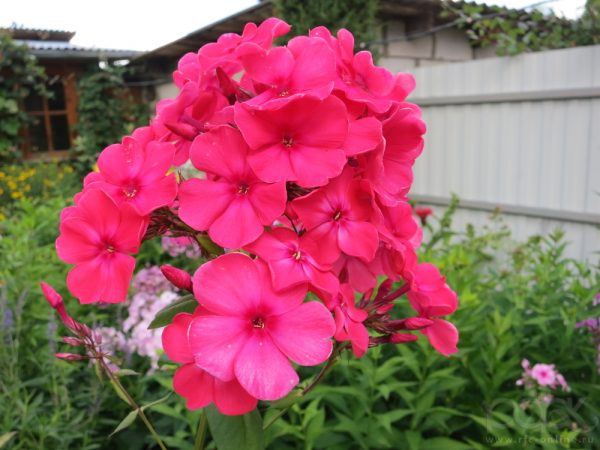

Phlox panicled "Margarita"
Phloxes, which have spotted petals, are especially beautiful. It is the combination of different shades that attracts the eyes of others to the flowerbed, which is decorated with this plant. Breeders of the whole world do not stop working on this species.
Every year there are more and more new color options. Among the most popular are:
«Ivan»Which blooms in the middle of the summer season.
«Europe»From mid-summer to autumn.
«Miss pepper"And"Bright eyes»Also produce inflorescences in the middle of summer.
«Feelings"Or" Feelings "is a special variety of phlox, with which breeders in England and Holland work.
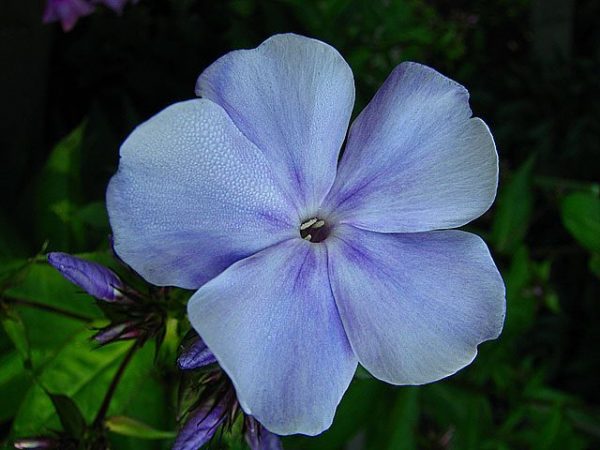

Phlox panicled "Ivan"
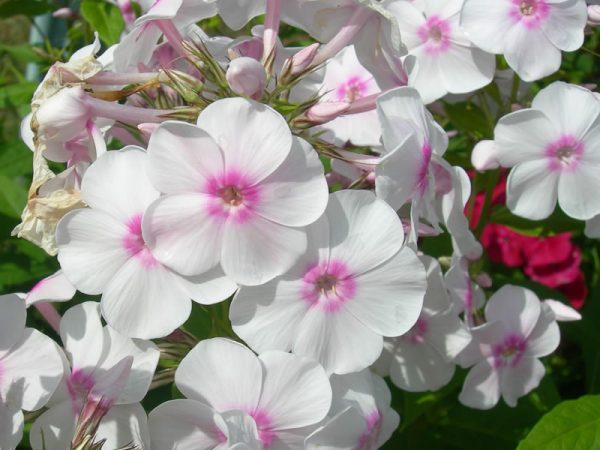

Phlox panicled "Europe"
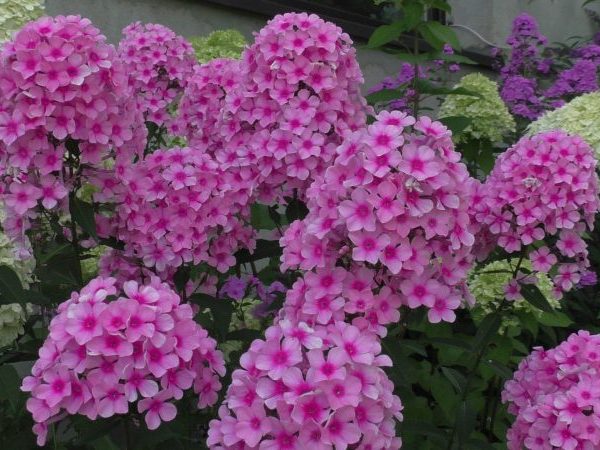

Phlox panicled Miss Pepper
Also, experts distinguish here another subspecies of plants, which are distinguished by special inflorescences. Their buds never bloom, that's why they were called "buds". These varieties include "Red feelings"And"Natural feelings».
How to achieve more effect
When the ideal flower garden is drawn up and the most suitable neighborhood is chosen, the color combination of perennial plants can become a little boring. In this case, you can diversify the shades of the main plant.Using the root separation method, it is possible to free up areas of soil in the flower bed and plant phlox of a lighter, or, on the contrary, dark shades.
A wonderful option is playing with light and the curly arrangement of phloxes on a flower bed. Gradient planting of various shades of flowers will allow you to admire the flower bed for a long time and constantly discover new motives.
How to care for subulate phlox?
When it comes to leaving, it requires:
- Elimination of weeds.
- Watering with water at room temperature.
- Removing inflorescences that have already bloomed.
- In order for the flowering to be long and beautiful, phlox needs to be transplanted every five years.
The plant is quite frost-resistant, but only under the condition when there is a lot of snow. And in the fall, the entire top is cut off, the roots are sprinkled with earth and peat. Covering phlox with straw or fallen leaves is also a good option.
Photo:
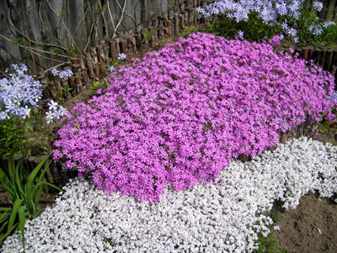

Top dressing for beautiful flowering
The flower garden should not be allowed to dry out. In hot weather, watering is required daily, in cool weather - 1-3 times a week. Top dressing for a flower bed with phlox should be applied only to wet soil. This is how the fertilizer is absorbed best. The most suitable times for feeding are before and after flowering.
Important! During the growing season, complementary foods are best cut down so as not to harm the inflorescences.
Mineral and organic substances of natural origin are suitable as fertilizers. You can also feed with combined fertilizers sold in specialized stores, they have different names, new types are provided every year. Therefore, the description should indicate that the fertilizers are suitable for phlox. The plant will benefit from ash mulching. It is recommended to cover the roots with nutritious soil for the winter.
To create a unique flower garden on a personal garden plot, it all depends on the scope and imagination of the gardener. A flowerbed with phlox, arranged in the local area, is unique in that it can be combined with any plants, and only benefit from it. In addition, phloxes are frost-resistant and rather unpretentious, so both experienced and novice gardeners can cope with them.
You need to know what phlox is combined with, and then they will create ideal compositions with roses, host, fern, gladioli, marigolds and other common flowers. The main thing in organizing a flower garden is to give freedom to desires and imaginations.
Popular varieties
Bayern Munich
This is one of the most sought after varieties. The inflorescences have two shades at once - the petals are white, they have lavender stripes on them. They delight with their flowering twice a season - in June and August. Height - up to 15 cm. Very decorative variety, grows in diameter up to half a meter.
"Bonita"
The uniqueness of the variety is that it grows very quickly and well. One season can change your flower bed, making it a delicate lilac color. The variety winters well, is not afraid of trampling. Height - 5-15 cm, blooms in late spring and early summer. One of the most undemanding varieties.
"CandyStripes"
Here you can just look at the photo of the styloid phlox in landscape design, and everything will become clear. The flowers are candy-like, striped and very decorative. It blooms in late May and June, requires only watering and feeding 1-2 times. Winters well in all regions. Height - up to 15 cm, diameter - 60 cm or more.
Wilson
It is also an unpretentious variety and is very often found in the flower beds of summer residents. It goes well with primroses, suitable for various landscape solutions. The variety creates a very dense carpet up to 20 cm in height. It blooms in late spring and early summer.
"White Delight"
These subulate phloxes are snow-white. Decorate any flower bed, rock garden, border. You can plant the variety in flowerpots. It will grow no more than 15 cm, it blooms, like most varieties, for a month - at the end of May and June, but it will also please in August and September.
For information! Phlox subulate have hybrid varieties and simple ones. Each has pluses, but the latter are more hardy. If you have poor conditions, the climate is harsh, the soil is poor, then it is better to choose them.
NettletonVariations
The variety is decorative both with inflorescences and leaves. This gives an advantage, since after flowering the plant still looks very aesthetically pleasing. Height - no more than 10 cm, petals - lilac shade. It blooms in late May and early June. Diameter - up to 50 cm.
Of course, there are much more varieties, but today we are talking about planting subulate phlox and caring for it. When choosing flowers for your garden, try to choose the types not only according to the principle - which you liked will grow, but also so that they are combined with each other in shade and appearance. Also choose plants so that they can bloom in turns - the club will always be beautiful. And let's move on to the main secrets of growing.
How to water phlox and how to mulch
Unfortunately, even with the right fertilization, you won't be able to get beautiful flowers if you don't water the phlox. The culture is very demanding on moisture, so the soil should not be allowed to dry out. The soil should be kept moist throughout the growing season.
The root system of phlox is close to the soil surface, powerful roots lie at a depth of no more than 20-25 cm, so you often have to irrigate plantings. In addition, during the period of growing green mass, the appearance of buds and flowering, plants absorb more water.
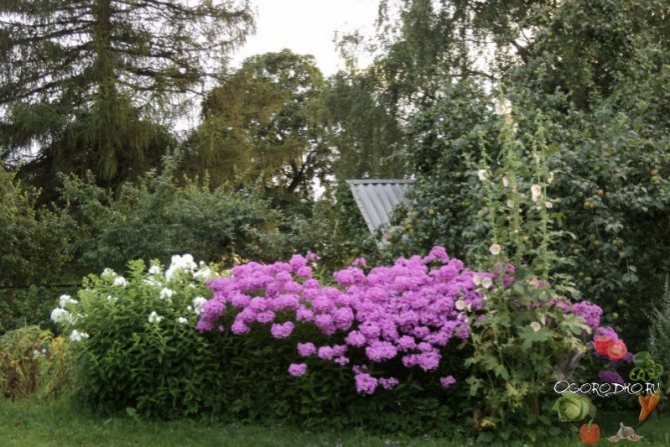

If watering phlox is not enough, you can see that the stems grow thinner and smaller, inflorescences are poorly formed, small flowers appear. How much water does phlox need? There should be enough water so that the entire root layer is well moistened, and the roots of the plant are sufficiently nourished. As a rule, 1 sq. m. area requires 1.5-2 buckets of water.
After watering, the soil needs to be loosened, but not deeply. Many gardeners skillfully use such a wonderful tool for loosening as the Fokin flat cutter, which is easy and convenient to work with.
In order to retain moisture in the soil in a hot dry summer, phloxes need to be mulched. As mulch, they take straw, hay, cut grass, peat or humus. Particular attention should be paid to plants with a large horse system, especially in which the rhizome protrudes. It is advisable to mulch phloxes for the winter so that the root does not die in severe frosts.
Growing, planting and caring for phlox
In order for these beautiful flowers to please your eye for more than one year, you need to adhere to certain rules for care and cultivation:
- The best place to grow phlox will be a shaded, level area, preferably with excess water outflow. The shade from the trees in the summer will save these flowers from the excessive influence of the sun and give them a long time to bloom, and the nearby shrubs will save them from hot winds.
- A loosened, well-fertilized and moist soil is an excellent area for phlox flowering. Insufficient moisture leads to an increase in the amount of salts in the soil, which leads to browning of the leaves and the plants become lethargic. It is highly undesirable to plant phlox on clay soil.
- The land must be prepared in advance, if planting occurs in the spring, then the soil is prepared in the fall. If you plant in the fall, then the preparatory work takes place in the summer.
- Planting is desirable in early spring or late summer, since the soil is sufficiently moist, the temperature is favorable, which contributes to rapid rooting.
- With insufficient moisture, neither proper planting, nor timely replenishment will give the desired result. It will be beneficial to keep the earth always moist.
The best species of tall perennial phlox
Creeping phlox, plant along the fence and hedges. The most popular varieties of these varieties:
- Altair... During the day, its color is deep pink, and in the morning and evening, or also at cool temperatures, the flowers acquire a blue tone. In the center there is a small asterisk, darker than the main color, around which there is a slight lightening. The first flowers are larger. The inflorescence is round-conical, large, dense. The bush is powerful, erect. The leaf is dark green, large. Winter hardy.
- Berendey... It was withdrawn relatively recently, in 2007. Has a lilac-purple gradient, when fully dissolved it appears to be a silvery-gray with a smoky effect. With a diameter of 4 cm, it has a large inflorescence and a strong stem.
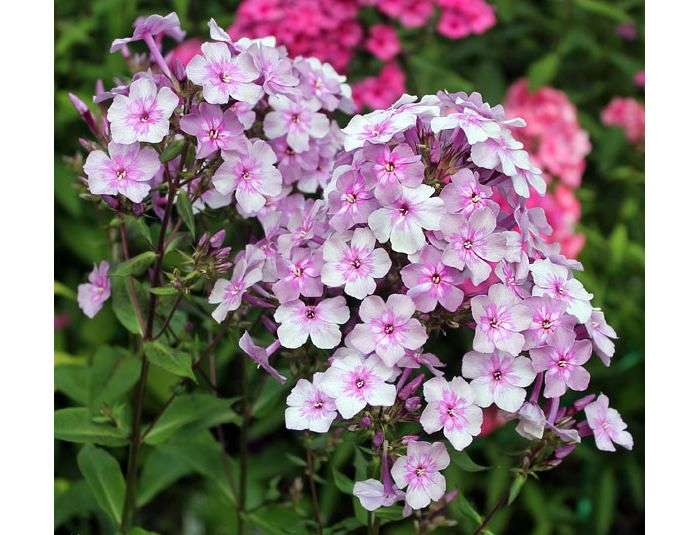

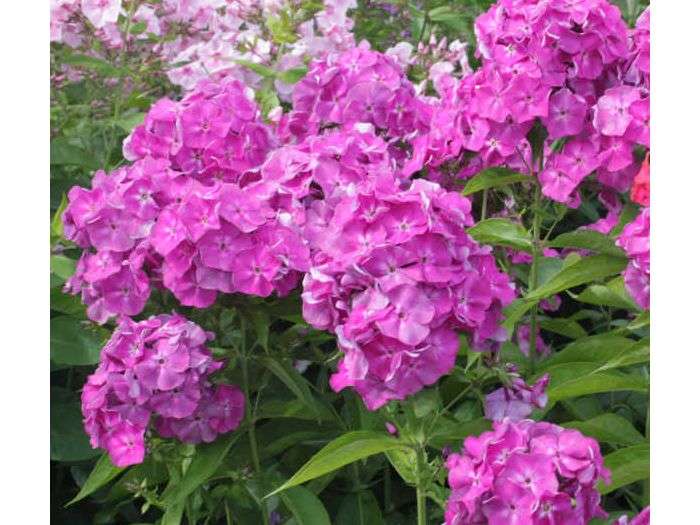

Despite the light-loving nature of this variety of phlox, it is recommended to choose a place with diffused sunlight for planting. Observe a distance of 40-60 cm when planting, because they grow for 7 years in the same place. Plants are widely used in garden design and are also ideal for single plantings, especially on green lawns.


